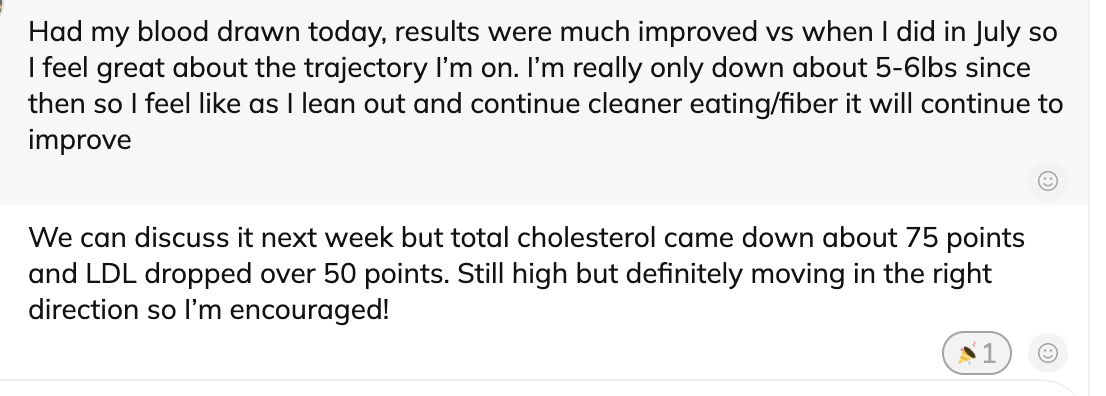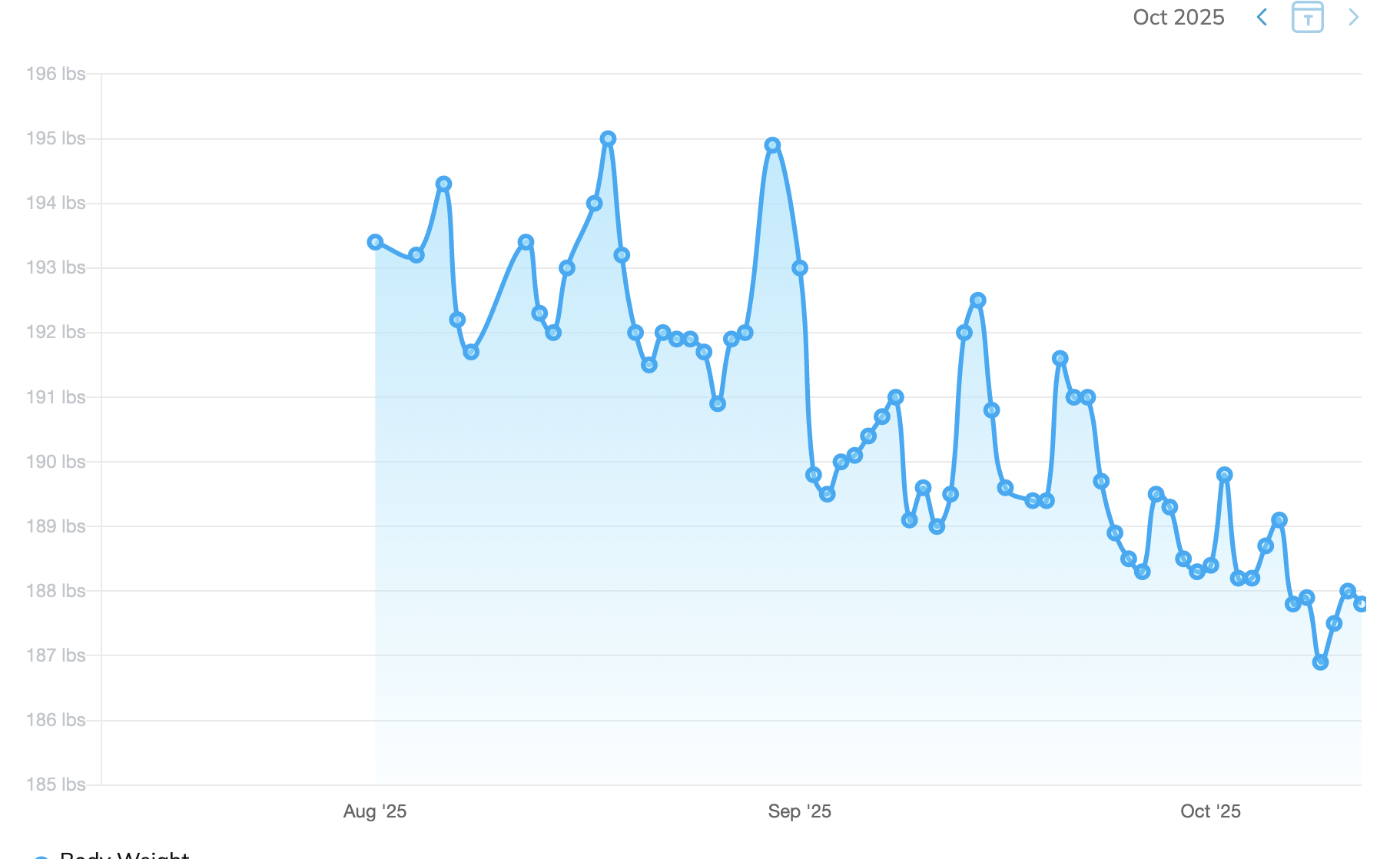How To Lower Your Cholesterol Without Statins
“Had my blood drawn today—total cholesterol down 75 points. LDL dropped over 50. Still high, but trending right. I’m only down six pounds and haven’t been perfect—but something’s clearly working.”
That’s from a real client in his 30s. Made my freakin' day.
Why?
Because 95% of fitness talk is about what you can see: the scale, a smaller waist, bigger biceps, rounder glutes. But the real wins often happen under the hood.
If you’ve got high cholesterol (or high blood pressure or blood sugar), and you use exercise and nutrition to bring those numbers down—you’re not just getting “healthier.” You’re buying time. More holidays. More Super Bowls. More memories. And slashing your risk of the stuff nobody wants: heart attacks, strokes, dementia.
This client got leaner and stronger in just 8 weeks. But the real win—the one that could change the next 40 years of his life—is in the habits that improved his blood work.
Here are five simple, proven ways to lower your cholesterol without statins.
A Quick Note on Statins
Statins work. They’re safe, well-studied, and have helped millions lower their risk of heart disease and stroke.
This isn’t an anti-medication rant.
But statins can come with side effects—and plenty of people would rather see how far they can get with diet, exercise, and lifestyle first.
If that’s you, the next five steps are the place to start.
1. Eat More Fiber
I keep banging this drum, and people keep sleeping on fiber!
Yeah, it helps you stay full and manage your weight—but it also plays a direct role in lowering cholesterol. Soluble fiber binds to cholesterol in your gut and helps flush it out before it ever hits your bloodstream.
It’s simple, effective, and backed by decades of research. In fact, every 10g bump in daily fiber intake is linked to a 10% drop in dying from any cause.
Most people need 25–30g/day. The average American gets about 16g/day.
Some of the best sources:
Oats
Beans and lentils
Nuts and seeds
Fruits and vegetables
Start slow. Going from 10g to 30g overnight? Your digestive system will file a complaint.
Action step: Add 2 servings of high-fiber foods per day for the next two weeks. That alone can move the needle.
2. Cut Back on Saturated Fat
I put a ridiculous amount of butter on my bread at dinner last night. You don’t need to cut out butter—or any single food—to be healthy.
BUT, saturated fat raises LDL (“bad”) cholesterol. That’s well established in the research.
Here’s how: when you eat a lot of saturated fat, it reduces the number of LDL receptors in your liver—the things responsible for clearing LDL (“bad” cholesterol) from your bloodstream. Fewer receptors = more LDL hanging around in your blood. And the longer it sticks around, the more likely it is to end up in your artery walls.
If your LDL is high, trimming back on saturated fat can make a measurable difference.
Common sources to watch:
Fatty cuts of red meat
Butter and cream
Coconut oil
Packaged snacks and fast food
Action step: Once a day, swap out a high-saturated-fat meal for something leaner—like chicken, turkey, fish, or plant-based fats like olive oil, nuts, or avocado.
3. Cut Back on Added Sugar (Especially the Sneaky Kind)
Sugar doesn’t just spike your blood glucose—it also drives up triglycerides and contributes to higher LDL cholesterol over time.
Here’s what’s happening: when you eat a lot of added sugar, your liver turns that excess glucose and fructose into triglycerides (fat). This process—called de novo lipogenesis—raises blood triglyceride levels and creates smaller, denser LDL particles.
Those smaller LDL particles are more likely to slip into artery walls and cause damage.
Common culprits:
Sugary drinks (soda, sweetened coffee, “healthy” energy drinks)
Flavored yogurts
Sauces, dressings, and condiments
Protein bars with more sugar than protein
Action step: Start by cutting liquid sugar—that’s where most people see the fastest results. Then pick one or two processed foods you eat often and check the label. Aim for under 10g of added sugar per serving.
4. Lose Fat (Even a Little Helps a Lot)
You don’t need to get shredded. You just need less visceral fat—the deep belly fat that wraps around your organs and messes with your cholesterol, blood pressure, and insulin sensitivity.
Here’s why it matters: visceral fat isn’t just sitting there. It’s metabolically active, constantly releasing free fatty acids and inflammatory molecules into your bloodstream. That flood of fatty acids forces your liver to produce more VLDL and LDL cholesterol, while inflammation makes your blood vessels less responsive and more prone to plaque buildup.
Even a small change helps. Losing just 10% of your bodyweight can significantly improve total cholesterol, LDL, and triglycerides.
How to do it:
Create a small calorie deficit
Aim for 8k+ steps per day
Prioritize protein and fiber
Lift weights 2–3x per week
If you’re serious about getting lean and keeping it that way, let’s work together. In 6–12 months, we’ll build the habits, lose the fat, and create a plan that lasts for the rest of your life
Action step: Track your average weight for 2 weeks. If it’s flat, shave 300–500 calories per day and increase movement slightly. Even slow progress adds up fast at the metabolic level.
5. Move More
Exercise improves your cholesterol levels—even if the scale doesn’t budge!
Here’s what’s happening under the hood: physical activity increases the activity of enzymes like lipoprotein lipase, which helps clear triglycerides from your bloodstream and convert LDL particles into larger, less harmful forms. It also boosts HDL, the cholesterol that helps carry excess fat and cholesterol back to the liver for removal.
In short: move more, and your body gets better at managing fat and cholesterol.
Best combo:
Aerobic work (3-5x/week - walking, biking, cardio machines, anything you enjoy)
Strength training (2–3x per week for muscle and metabolic health)
Action step: Get 30 minutes of walking most days, and add 2 short lifting sessions per week. Build from there.
The Bottom Line
You won’t always feel different when your cholesterol improves. No confetti. No six-pack. Nothing you’ll notice in the mirror tomorrow.
But under the hood? Everything gets better. Lower LDL and triglycerides, higher HDL, better insulin sensitivity, less inflammation. That means less plaque in your arteries. Lower risk of heart attack, stroke, dementia, and death. Simple, consistent effort can buy you decades of better health.
And if you want help transforming your health—without relying on medication—I’ve been helping people do exactly that since 2018.
Apply for coaching below and save $500 when you apply before midnight on Halloween.
Best,
John
P.S. Full message from my client Ben is below, along with his fat-loss graph. In just 8 weeks, he’s down 8 pounds, dropped 3–5% body fat, pulled 355×8 on deadlifts, and improved his cholesterol. He’s on fire!
3 Steps You Can Take
Apply for coaching - If you’re ready to start, you can fill out a coaching application here (it takes 90 seconds or less). Best case, you change your life. Worst case, I’ll help you draw up a road map to get closer to your goals.
Sign up for my newsletter - If you’d like to hear more, sign up for my mailing list here.
Keep learning - You can check out my other articles here. Nobody asked me to, but I’ve spent a ton of time researching everything from artificial sweeteners to saturated fat to testosterone and more, so you don’t have to.



